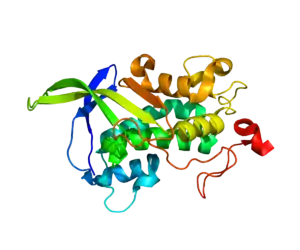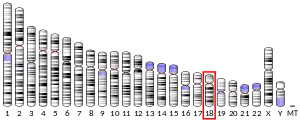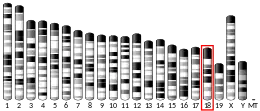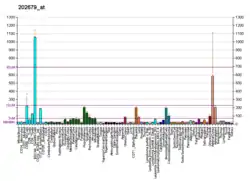NPC1
Niemann-Pick disease, type C1 (NPC1) is a disease of a membrane protein that mediates intracellular cholesterol trafficking in mammals. In humans the protein is encoded by the NPC1 gene (chromosome location 18q11).[5][6]
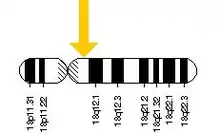
Function
NPC1 was identified as the gene that when mutated, results in Niemann-Pick disease, type C. Niemann-Pick disease, type C is a rare neurovisceral lipid storage disorder resulting from autosomal recessively inherited loss-of-function mutations in either NPC1 or NPC2. This disrupts intracellular lipid transport, leading to the accumulation of lipid products in the late endosomes and lysosomes. Approximately 95% of NPC patients are found to have mutations in the NPC1 gene.
NPC1 encodes a putative integral membrane protein containing sequence motifs consistent with a role in intracellular transport of cholesterol to post-lysosomal destinations.[5][7]
Clinical significance
Obesity
Mutations in the NPC1 gene have been strongly linked with obesity.[8] A genome-wide association study identified NPC1 mutations as a risk factor in childhood obesity and adult morbid obesity, and 1,416 age-matched normal weight controls.[8] Mutations in NPC1 were also correlated with ordinary weight gain in the population. Previous studies in mice have suggested that the NPC1 gene has a role in controlling appetite, as mice with a non-functioning NPC1 gene suffer late-onset weight loss and have poor food intake. NPC1 gene variant could account for around 10 per cent of all childhood obesity and about 14 per cent of adult morbid obesity cases.[8]
HIV-AIDS
Cholesterol pathways play an important role at multiple stages during the HIV-1 infection cycle. HIV-1 fusion, entry, assembly, and budding occur at cholesterol-enriched microdomains called lipid rafts. The HIV-1 accessory protein, Nef, has been shown to induce many genes involved in cholesterol biosynthesis and homeostasis. Intracellular cholesterol trafficking pathways mediated by NPC1 are needed for efficient HIV-1 production.[9][10]
Ebola virus
The human Niemann–Pick C1 (NPC1) cholesterol transporter appears to be essential for Ebola virus infection: a series of independent studies have presented evidence that Ebola virus enters human cells after binding to NPC1.[11][12] When cells from Niemann Pick Type C patients lacking this transporter were exposed to Ebola virus in the laboratory, the cells survived and appeared impervious to the virus, further indicating that Ebola relies on NPC1 to enter cells.[12] The same studies described similar results with Marburg virus, another filovirus, showing that it too needs NPC1 to enter cells.[11][12] In one of the studies, NPC1 was shown to be critical to filovirus entry because it mediates infection by binding directly to the viral envelope glycoprotein.[12] A later study confirmed the findings that NPC1 is a critical filovirus receptor that mediates infection by binding directly to the viral envelope glycoprotein and that the second lysosomal domain of NPC1 mediates this binding.[13]
In one of the original studies, a small molecule was shown to inhibit Ebola virus infection by preventing the virus glycoprotein from binding to NPC1.[12][14] In the other study, mice that were heterozygous for NPC1 were shown to be protected from lethal challenge with mouse adapted Ebola virus.[11] Together, these studies suggest NPC1 may be potential therapeutic target for an Ebola anti-viral drug.
Mechanisms in pathology
In a mouse model carrying the underlying mutation for Niemann-Pick type C1 disease in the NPC1 protein, the expression of Myelin gene Regulatory Factor (MRF) has been shown to be significantly decreased.[15] MRF is a transcription factor of critical importance in the development and maintenance of myelin sheaths.[16] A perturbation of oligodendrocyte maturation and the myelination process might therefore be an underlying mechanism of the neurological deficits.[15]
References
- GRCh38: Ensembl release 89: ENSG00000141458 - Ensembl, May 2017
- GRCm38: Ensembl release 89: ENSMUSG00000024413 - Ensembl, May 2017
- "Human PubMed Reference:". National Center for Biotechnology Information, U.S. National Library of Medicine.
- "Mouse PubMed Reference:". National Center for Biotechnology Information, U.S. National Library of Medicine.
- "Entrez Gene: NPC1 Niemann-Pick disease, type C1".
- Carstea ED, Polymeropoulos MH, Parker CC, Detera-Wadleigh SD, O'Neill RR, Patterson MC, et al. (March 1993). "Linkage of Niemann-Pick disease type C to human chromosome 18". Proceedings of the National Academy of Sciences of the United States of America. 90 (5): 2002–4. doi:10.1073/pnas.90.5.2002. PMC 46008. PMID 8446622.
- Carstea ED, Morris JA, Coleman KG, Loftus SK, Zhang D, Cummings C, et al. (July 1997). "Niemann-Pick C1 disease gene: homology to mediators of cholesterol homeostasis". Science. 277 (5323): 228–31. doi:10.1126/science.277.5323.228. PMID 9211849.
- Meyre D, Delplanque J, Chèvre JC, Lecoeur C, Lobbens S, Gallina S, et al. (February 2009). "Genome-wide association study for early-onset and morbid adult obesity identifies three new risk loci in European populations". Nature Genetics. 41 (2): 157–9. doi:10.1038/ng.301. PMID 19151714. S2CID 11218794.
- Tang Y, Leao IC, Coleman EM, Broughton RS, Hildreth JE (August 2009). "Deficiency of niemann-pick type C-1 protein impairs release of human immunodeficiency virus type 1 and results in Gag accumulation in late endosomal/lysosomal compartments". Journal of Virology. 83 (16): 7982–95. doi:10.1128/JVI.00259-09. PMC 2715784. PMID 19474101.
- Coleman EM, Walker TN, Hildreth JE (January 2012). "Loss of Niemann Pick type C proteins 1 and 2 greatly enhances HIV infectivity and is associated with accumulation of HIV Gag and cholesterol in late endosomes/lysosomes". Virology Journal. 9 (1): 31. doi:10.1186/1743-422X-9-31. PMC 3299633. PMID 22273177.
- Carette JE, Raaben M, Wong AC, Herbert AS, Obernosterer G, Mulherkar N, et al. (August 2011). "Ebola virus entry requires the cholesterol transporter Niemann-Pick C1". Nature. 477 (7364): 340–3. doi:10.1038/nature10348. PMC 3175325. PMID 21866103. Lay summary – New York Times.
- Côté M, Misasi J, Ren T, Bruchez A, Lee K, Filone CM, et al. (August 2011). "Small molecule inhibitors reveal Niemann-Pick C1 is essential for Ebola virus infection". Nature. 477 (7364): 344–8. doi:10.1038/nature10380. PMC 3230319. PMID 21866101. Lay summary – New York Times.
- Miller EH, Obernosterer G, Raaben M, Herbert AS, Deffieu MS, Krishnan A, et al. (April 2012). "Ebola virus entry requires the host-programmed recognition of an intracellular receptor". The EMBO Journal. 31 (8): 1947–60. doi:10.1038/emboj.2012.53. PMC 3343336. PMID 22395071.
- Flemming A (September 2011). "Achilles heel of Ebola viral entry". Nature Reviews. Drug Discovery. 10 (10): 731. doi:10.1038/nrd3568. PMID 21959282. S2CID 26888076.
- Yan X, Lukas J, Witt M, Wree A, Hübner R, Frech M, et al. (December 2011). "Decreased expression of myelin gene regulatory factor in Niemann-Pick type C 1 mouse". Metabolic Brain Disease. 26 (4): 299–306. doi:10.1007/s11011-011-9263-9. PMID 21938520. S2CID 26878522.
- Koenning M, Jackson S, Hay CM, Faux C, Kilpatrick TJ, Willingham M, Emery B (September 2012). "Myelin gene regulatory factor is required for maintenance of myelin and mature oligodendrocyte identity in the adult CNS". The Journal of Neuroscience. 32 (36): 12528–42. doi:10.1523/JNEUROSCI.1069-12.2012. PMC 3752083. PMID 22956843.
Further reading
- Vanier MT, Suzuki K (January 1998). "Recent advances in elucidating Niemann-Pick C disease". Brain Pathology. 8 (1): 163–74. doi:10.1111/j.1750-3639.1998.tb00143.x. PMID 9458174. S2CID 10300500.
- Liscum L, Klansek JJ (April 1998). "Niemann-Pick disease type C". Current Opinion in Lipidology. 9 (2): 131–5. doi:10.1097/00041433-199804000-00009. PMID 9559270.
- Morris JA, Carstea ED (December 1998). "Niemann-Pick C disease: cholesterol handling gone awry". Molecular Medicine Today. 4 (12): 525–31. doi:10.1016/S1357-4310(98)01374-4. PMID 9866822.
- Garver WS, Heidenreich RA (August 2002). "The Niemann-Pick C proteins and trafficking of cholesterol through the late endosomal/lysosomal system". Current Molecular Medicine. 2 (5): 485–505. doi:10.2174/1566524023362375. PMID 12125814.
- Greer WL, Riddell DC, Byers DM, Welch JP, Girouard GS, Sparrow SM, et al. (July 1997). "Linkage of Niemann-Pick disease type D to the same region of human chromosome 18 as Niemann-Pick disease type C". American Journal of Human Genetics. 61 (1): 139–42. doi:10.1086/513899. PMC 1715879. PMID 9245994.
- Greer WL, Riddell DC, Gillan TL, Girouard GS, Sparrow SM, Byers DM, et al. (July 1998). "The Nova Scotia (type D) form of Niemann-Pick disease is caused by a G3097-->T transversion in NPC1". American Journal of Human Genetics. 63 (1): 52–4. doi:10.1086/301931. PMC 1377252. PMID 9634529.
- Watari H, Blanchette-Mackie EJ, Dwyer NK, Glick JM, Patel S, Neufeld EB, et al. (February 1999). "Niemann-Pick C1 protein: obligatory roles for N-terminal domains and lysosomal targeting in cholesterol mobilization". Proceedings of the National Academy of Sciences of the United States of America. 96 (3): 805–10. doi:10.1073/pnas.96.3.805. PMC 15306. PMID 9927649.
- Patel SC, Suresh S, Kumar U, Hu CY, Cooney A, Blanchette-Mackie EJ, et al. (February 1999). "Localization of Niemann-Pick C1 protein in astrocytes: implications for neuronal degeneration in Niemann- Pick type C disease". Proceedings of the National Academy of Sciences of the United States of America. 96 (4): 1657–62. doi:10.1073/pnas.96.4.1657. PMC 15549. PMID 9990080.
- Morris JA, Zhang D, Coleman KG, Nagle J, Pentchev PG, Carstea ED (August 1999). "The genomic organization and polymorphism analysis of the human Niemann-Pick C1 gene". Biochemical and Biophysical Research Communications. 261 (2): 493–8. doi:10.1006/bbrc.1999.1070. PMID 10425213.
- Yamamoto T, Nanba E, Ninomiya H, Higaki K, Taniguchi M, Zhang H, et al. (1999). "NPC1 gene mutations in Japanese patients with Niemann-Pick disease type C". Human Genetics. 105 (1–2): 10–6. doi:10.1007/s004390051057. PMID 10480349.
- Greer WL, Dobson MJ, Girouard GS, Byers DM, Riddell DC, Neumann PE (November 1999). "Mutations in NPC1 highlight a conserved NPC1-specific cysteine-rich domain". American Journal of Human Genetics. 65 (5): 1252–60. doi:10.1086/302620. PMC 1288277. PMID 10521290.
- Millat G, Marçais C, Rafi MA, Yamamoto T, Morris JA, Pentchev PG, et al. (November 1999). "Niemann-Pick C1 disease: the I1061T substitution is a frequent mutant allele in patients of Western European descent and correlates with a classic juvenile phenotype". American Journal of Human Genetics. 65 (5): 1321–9. doi:10.1086/302626. PMC 1288284. PMID 10521297.
- Davies JP, Ioannou YA (August 2000). "Topological analysis of Niemann-Pick C1 protein reveals that the membrane orientation of the putative sterol-sensing domain is identical to those of 3-hydroxy-3-methylglutaryl-CoA reductase and sterol regulatory element binding protein cleavage-activating protein". The Journal of Biological Chemistry. 275 (32): 24367–74. doi:10.1074/jbc.M002184200. PMID 10821832.
- Millat G, Marçais C, Tomasetto C, Chikh K, Fensom AH, Harzer K, et al. (June 2001). "Niemann-Pick C1 disease: correlations between NPC1 mutations, levels of NPC1 protein, and phenotypes emphasize the functional significance of the putative sterol-sensing domain and of the cysteine-rich luminal loop". American Journal of Human Genetics. 68 (6): 1373–85. doi:10.1086/320606. PMC 1226124. PMID 11333381.
- Sun X, Marks DL, Park WD, Wheatley CL, Puri V, O'Brien JF, et al. (June 2001). "Niemann-Pick C variant detection by altered sphingolipid trafficking and correlation with mutations within a specific domain of NPC1". American Journal of Human Genetics. 68 (6): 1361–72. doi:10.1086/320599. PMC 1226123. PMID 11349231.
External links
| Wikimedia Commons has media related to NPC1. |
- NPC1+protein,+human at the US National Library of Medicine Medical Subject Headings (MeSH)
- Fight NPC, a website dedicated to providing information and resources on treating Niemann–Pick type C disease
- Hide & Seek Foundation for Lysosomal Disease Research
This article incorporates text from the United States National Library of Medicine, which is in the public domain.
